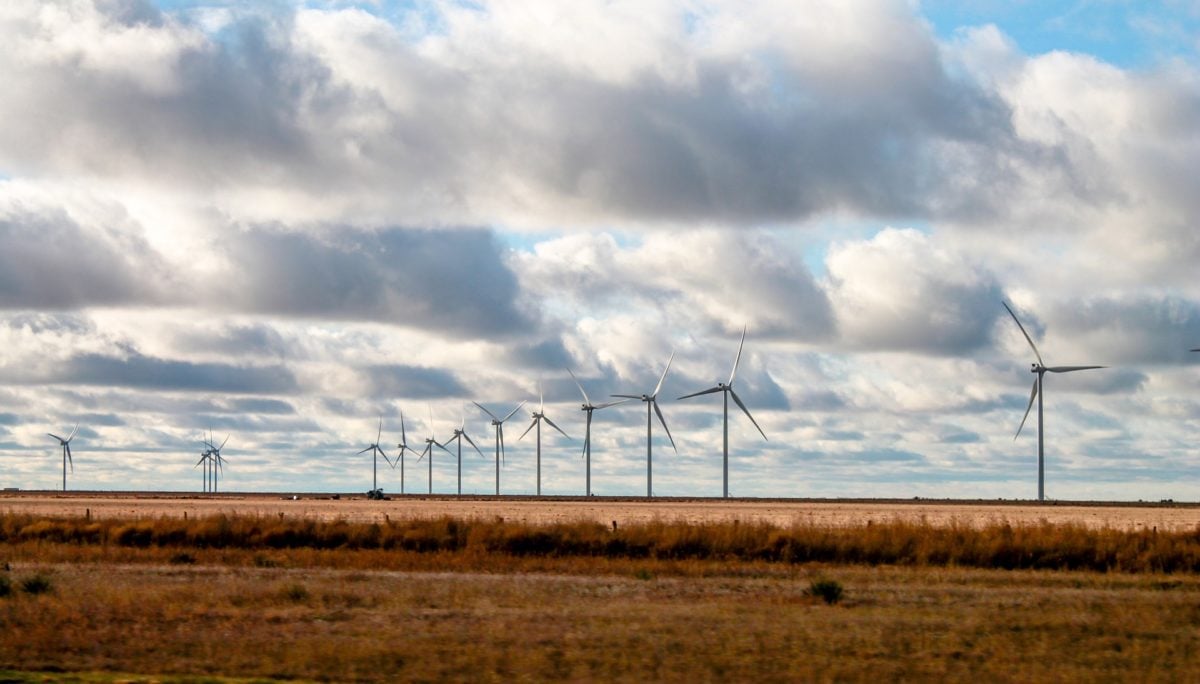
What to do With a “Tidal Wave” of Texas Wind Turbine Blades
The wind energy industry is struggling to find sustainable solutions for fast-accumulating piles of dead wind turbine blades. So far, all the options come with an environmental price.
A version of this story ran in the March / April 2021 issue.
Towns the size of Sweetwater normally don’t need many graveyards. The rural community of about 11,000 people is located in the impossibly flat plains west of Abilene and is best known for the 2,000 wind turbines that surround the area. More wind energy is produced in Nolan County than almost anywhere else on the planet, but since this place has given birth to such a staggering number of turbines, it now accommodates more than its fair share of dead ones, too.
Just south of town, on the west side of Highway 70, hundreds of fiberglass wind turbine blade chunks are piled into a 10-acre pasture. They have been cut into three pieces, laid down and piled up like empty straw wrappers discarded by giants. This is one of Texas’ first wind turbine graveyards. Fittingly, a second one has emerged across the street from Sweetwater’s town cemetery, this one more than 25 acres in size. As wind turbine blades increasingly reach the end of their useful lives, normally 25 to 30 years, more of these sites are expected to pop up across the state and nation. So far, no one has figured out a good way to get rid of the blades.And in the next decade, many of the 180,000 blades currently churning in U.S. airspace—more than one-quarter of which are in Texas alone—will come down.
A sign on the chain link fence separating the heap from the highway tells motorists that the blades are being prepared for recycling. That’s easier said than done. The blades, which are mostly made of fiberglass, carbon fiber, resin, and balsa wood, can’t be melted down and remanufactured like recycled aluminum cans or glass bottles. Blades get “recycled” by being shredded and mixed into construction materials or burned for cement production. Otherwise, they get hauled off to landfills. Each recycling process carries an environmental toll: a harsh reality for an industry that aims to replace coal by producing cleaner energy. The problem will come to a head in Texas, which leads the nation in wind energy production.
The state’s first modern wind turbines went up in the late ’90s. By 2006, Texas had replaced California as the top wind energy-producing state and has held the title ever since. Large, flat expanses of blustery land have made West Texas the ideal place for energy companies to build out the state’s wind energy capacity. The state’s laissez-faire attitude toward regulation has also made Texas an attractive site for development. But the state’s aging turbines, some of which are now more than two decades old, are nearing the age where they need to be replaced or decommissioned.
Replacing a turbine’s older parts—or “repowering” the machine, in industry parlance—is a popular strategy for extending a turbine’s lifespan, partially because it allows developers to continue availing themselves to federal tax credits. But repowering can also double the amount of blade waste created by a single turbine, entering six blades into the waste stream instead of three by the time it reaches end of life and requires dismantling and decommissioning. In Texas, that means 45,000 blades could become 90,000.
Despite the lack of sustainable options of blade recycling, creating electricity from wind power causes markedly less pollution than energy generated by fossil fuels. For instance, emissions from coal-fired power plants accounted for 952 million metric tons of carbon dioxide in 2019, according to the U.S. Energy Information Administration. Natural gas accounted for 560 million metric tons. Wind farms generate virtually no carbon dioxide, the primary driver of anthropogenic climate change.
The wind industry hopes that necessity will be the mother of invention. According to Hilary Clark, the social license director for the American Wind Energy Alliance (AWEA), the nationwide accumulation of blades from repowering and decommissioning is “spurring innovation” in sustainable disposal strategies to keep blades out of landfills.
Despite disinformation propagated by anti-wind groups, blades buried in landfills don’t leach chemicals into the ground. But they do stand to eat up a lot of space. Though the blades accounted for less than 0.1 percent of U.S. landfill waste in 2019, the Electric Power Research Institute estimates that four million tons of blade waste will go into U.S. landfills between 2020 and 2050. That’s equal to 40 of the world’s heaviest aircraft carriers, and about one-fifth of the amount of waste generated in Texas each year.
“We all of a sudden have an avalanche—or, a tidal wave, if you will—of blades coming off turbines,” says Derek Berry, senior wind technology engineer at the National Renewable Energy Laboratory (NREL). “There are hundreds of thousands, if not more, of wind turbine blades reaching end of life, and the industry has to find something to do with them.”
Due to the chemical makeup of turbine blades, reverting the materials to pre-blade form isn’t an option. “Once you create that wind turbine blade, using a thermosetting epoxy resin system, it is by and large an irreversible process,” Berry says. But cities are finding creative ways to put those blades to productive use. According to the AWEA, future pedestrians and cyclists might find themselves crossing a blade bridge, like one being tested in Ireland. Park-goers could snag a seat on a blade bench, keeping an eye on kids running around blade playgrounds, like this one in Rotterdam.
Some companies are trying to make blades more recyclable. For the last six years, Berry and the NREL have worked within the U.S. Department of Energy’s Institute for Advanced Composites Manufacturing and Innovation to design blades made from sturdy composites that can be melted down and remanufactured like aluminum or glass. Enter Elium. The material was invented by Paris-based chemical conglomerate Arkema, a name that Texas residents might remember from Hurricane Harvey in 2017, when floodwaters inundated an Arkema plant in southeast Texas, disabling the refrigeration system and causing toxic chemicals onsite to catch fire. The noxious cloud forced the evacuation of 200 residents and chemicals washed away from the plant contaminated nearby homes. Still, the Elium blades are reportedly truly recyclable, making them a dream solution for the wind industry and environmentalists alike.
Global Fiberglass Solutions, the company that owns Sweetwater’s two fields of trashed blades, has also entered the fray. The company says it plans to shred the blades into construction-grade fiberglass pellets and panels, but it doesn’t have a firm timeline for doing so.
Shortly after the company was founded, GFS purchased the old Sweetwater aluminum recycling plant and began buying up dead turbine blades from energy companies, laying them down in the field surrounding the building. The supply of blades has been steady since 2017 and there’s no end in sight, says Tatiana Golik, the company’s business development director. “[Old] blades are starting to be obsolete and new technologies are rising,” Golik says.
Today, GFS stores an estimated 6,000 blades, 80 percent of which are in Sweetwater. The other 20 percent are kept at a second location in Newton, Iowa. Golik says the company one day hopes to process 6,000 blades each year, but GFS has struggled to secure funding to purchase the requisite equipment. Until they do, the blades will continue to sit idle.
Many Nolan County residents rejoiced when GFS came to Sweetwater, Golik says. But those living adjacent to the plant in an apartment complex owned by the Sweetwater Public Housing Authority watched through a chain link fence as the dead blade piles grew like weeds. They stacked up against the property line, resting just a few yards away from clotheslines, patio furniture, barbecue grills, and soccer balls on tidy lawns.
More dead blades are stacked up on the side of Highway 40 outside of Vega, a town of fewer than 1,000 people in the windblown Texas Panhandle. They came from the nearby Wildorado Wind Ranch, built in 2007, which powers nearby homes. Siemens Gamesa Renewable Energy, the company that owns the wind farm, replaced the old blades on all of its turbines early last year.
Sean Farrell, the company’s head of onshore sales and marketing, says that the old blades will be crushed and sent to cement kilns to be burned as fuel. Some of the waste will also be used in the cement itself. Such plans appear to be gaining popularity: In December, GE Renewable Energy, the largest wind turbine manufacturer in the world, signed a multi-year contract with industrial solutions company Veolia North America, which will process the GE blades and supply them to the cement industry.* The company says in the news release that producing cement by burning old blades will reduce greenhouse gas emissions relative to burning coal, but evidence also suggests that the activity could create pollutants and particulate matter that threaten air quality surrounding the kilns.
Since cement is a component of concrete, the blades could also find their way into the supply chain for batch concrete plants in Texas. Concrete plants have raised the animus of their neighbors across the state because they emit particulate matter that is then carried to nearby homes, causing respiratory problems. Harris County alone counts at least 188 of the plants.
But these challenges are considered a small price to pay by those who demand a rapid national transition to renewable energy.
“Wind is critical to beating the climate challenge,” said Luke Metzger, executive director of Environment Texas. “Certainly there are some localized impacts that we need to address…but the big picture is that this is a profoundly critical industry. We need to promote its development.”
The wind energy industry will continue to tinker with new strategies for old blades, hopefully innovating beyond the current batch of Band-Aid solutions for the tens of thousands of turbines churning in U.S. airspace. But until a new option for disposal rises to the surface, Texas towns like Sweetwater might find themselves living among the dead for a while longer.
*This story has been corrected to reflect the fact that GE Renewable Energy’s contract is with industrial solutions company Veolia North America, which was misrepresented in a previous version of this story as a cement manufacturing company. Veolia will process the GE blades and supply them to the cement industry.
Read more from the Observer:
-
COVID-19’s Deadly Toll on Texas Workers: As COVID-19 devastates workers unable to stay home, families are left struggling for justice.
-
Texas Republicans Fanned the Flames of Insurrection Long Before January 6: It’s not just Ted Cruz. For years, Texas Republicans have fueled the toxic politics that led extremists to storm the Capitol.
-
Bringing the Dead Home: Thirty years after Congress passed the Native American Graves Protection and Repatriation Act, only a fraction of human remains held by Texas’ museums and universities have been returned.


